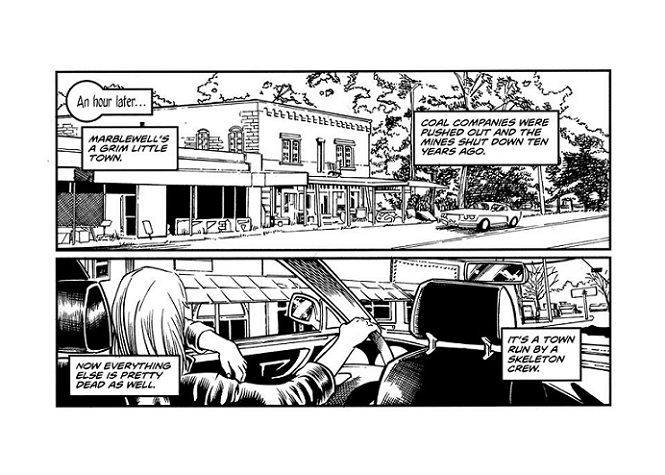First Comics News: How did the idea for “Charmer” come about?
Bill Williams: Charmer was born as another series was wrapping up. The nice folks at Austin Books threw a wake for Bill Willingham’s Fables series. I went down there for a bit and hung out with the old friends that were in town for the event. In passing, I heard that there was a perfect pitch document that Vertigo used. Being a process guy, I was interested in it and I had a chat with Shelly Bond who had edited Fables. After the talk, I wondered what in the world I could pitch to someone at Vertigo. I had written mysteries for the last few years and little I created seemed to fit their catalog.
Like a lot of writers, I have files and folders where I put the ideas that didn’t sell or didn’t quite come together right. I dusted off some of them and turned them over and over again to see if I could find a new angle on an old idea. There was a project I had that was about an outsider being recruited into a team of villains. When I changed the genre to supernatural and recast the characters, it started to come together. It caught traction in my head and I got a stupid amount of the prep work done.
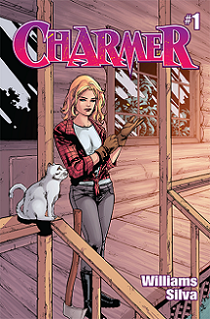 When I pulled the pitch together, I contacted Shelly and she told me they had a few projects in the works that were about cults. I’ve been told I have the worst skills for finding comic book work and this seemed like an extension of that. But I didn’t let go of the project, or it did not let go of me. So I wrote out the full script for the first issue and put an art team together. After some fits and starts, I had a first issue finished and just when I was about to format it for comiXology, I found Octal.
When I pulled the pitch together, I contacted Shelly and she told me they had a few projects in the works that were about cults. I’ve been told I have the worst skills for finding comic book work and this seemed like an extension of that. But I didn’t let go of the project, or it did not let go of me. So I wrote out the full script for the first issue and put an art team together. After some fits and starts, I had a first issue finished and just when I was about to format it for comiXology, I found Octal.
Mike Schneider, the editor on Octal, helped the project a lot. No matter how thorough you are as a creator, you always have blind spots about your work and a good second set of eyes will save you a lot of grief down the road. After the pitch was in Octal, I ran a Kickstarter and through that, I found a publisher. The first issue ships in March.
1st: Who is the main star in “Charmer”?
Bill: Samantha ‘Sam’ Wyrick has lived most of her life on the run. Always fearing that her Uncle’s cult would reenter her life, she trained and hardened herself for the coming fight. The story starts with her having that first skirmish with the cultists and it ends with her working for the people that killed her father. Of course, she works for them so she can exact revenge, so there is some tension there.
Samantha is a charmer, a sorceress. Early in the book, she uses a kind of magic when she is lured into a fight with a couple of suit-weaning goons. Sam’s world is mostly like ours but with some key differences that unspool as the series goes on.
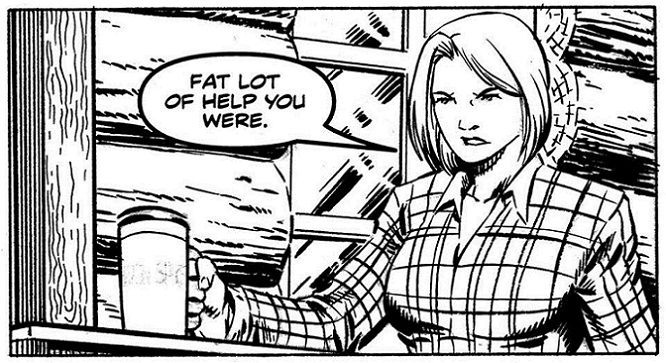
1st: Why will people love this young sorceress?
Bill: Sam is pretty unpredictable. She has a bleak sense of humor due to the trauma of her teen years. Sam also has a laser-like focus when it comes to the job at hand. Sam cheats in a fight whenever possible and she can be funny. At least, she thinks so.
1st: Who is the artist on “Charmer” and how would you describe their art?
Bill: Ricardo Silva pencils and inks the first issue of Charmer. He joined the Ed Benes Studio in 2006 and he shows the influences of Benes all throughout the Charmer pages. He’s good with action and the long talking heads scene I stuck him within the middle of the first issue. It couldn’t be helped really. The rest of the series is action packed and I needed a place to stash the set-up for the series. Seriously, Charmer is a pretty book.
Natalia Marques is an art instructor who also worked with Ed Benes Studio. She does the color work on the series. Thom Zahler letters the series and provides graphic support as we wrestle these things to press. I stepped in to ink the second issue of Charmer to make sure we stay on schedule.
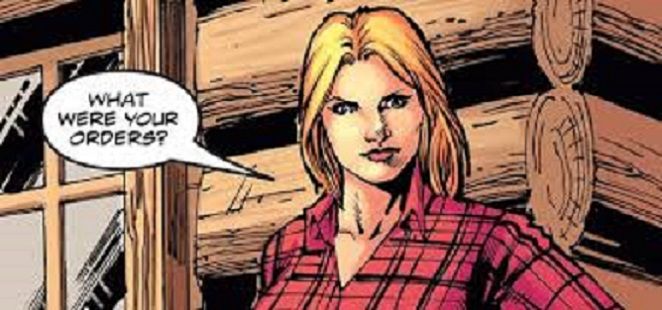
1st: What personality does your writing give to Samantha Wyrick?
Bill: Sam has a unique view of the world. She trained her whole life for a fight that’s finally here and a small part of her really enjoys the chance to cut loose. We spend a decent amount of time in Sam’s head between the narration and the dialogue and the conversations with Buddy.
Sam is guarded and cautious in part because she has imagined that a cult has been after her for her whole life.
1st: Can you tell us about the cult Samantha has to deal with in “Charmer”?
Bill: Ultraseptience is a global organization formed around the religious beliefs and practices handed down through the ages and popularized in the mid-1950s. The organization teaches that people can live fulfilled lives if they push past the seven deadly sins and tap into their unique hidden talents. While the public face of Ultraseptience has stated utopian aims, to achieve those goals, they get their hands dirty.
Sam’s Uncle Mike is a regional leader of the global organization. In the first issue, he essentially talks Sam into joining his ‘Black Ops’ team. He tells Sam he wants her help to find and acquire a Christian artifact. He tells her he needs someone he can trust. Sam accepts the offer because she wants to learn what happened the night her Father died and she wants to punish the guilty within the organization.
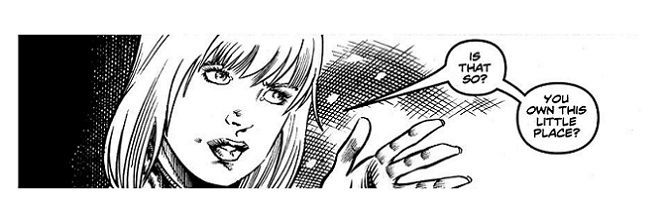
1st: Would “Charmer” make a good TV series or movie?
Bill: Every story has to be able to stand within the medium where it is presented. Our first concern is making a great comic book. So, I started with what I consider a good story and found a talented penciler and hoped for the best.
Of course, I would be lying if I said I did not consider the multi-media opportunities when I was building that story and building that world.
The first place I saw a perfect balance in the Short Form/ Long Form storytelling was in the First Season of Veronica Mars. She solved a crime of the week while she untangled a bit of the longer mystery narrative. Charmer could work along the same lines with a little tweaking with Sam going somewhere looking for something while she digs up dirt on her Uncle’s organization.
1st: How does one become a better writer?
Bill: Reading all of the time is a good step to becoming a better writer. Unfortunately, it gives you the tools to deconstruct everything you see as a media consumer. You learn how writers think. Eventually, you out think them some of the time.
I thought the Monk television show was off to a flawless start. Then it suffered a little Premise Creep, where for one reason or another, an artistic endeavor changes the promise of the premise and becomes something else over time. Anyway, I was watching an episode with my kid and kind of groaning. She asked why so I called what was happening in the story, like every single beat, a couple of minutes before it appeared on screen. Then she asked me to stop.
The best thing to have happen when you’re consuming media whether it is reading a book or a comic or watching television or a movie is to be surprised. Not with a lazy ‘everything you knew was wrong’ twist, but by a twist that legitimately comes up from the dark heart of the story.
To be a better writer, you have to write all of the damn time. You learn by repetition. You have to finish projects and let them go and move on to the next one. You learn by doing.
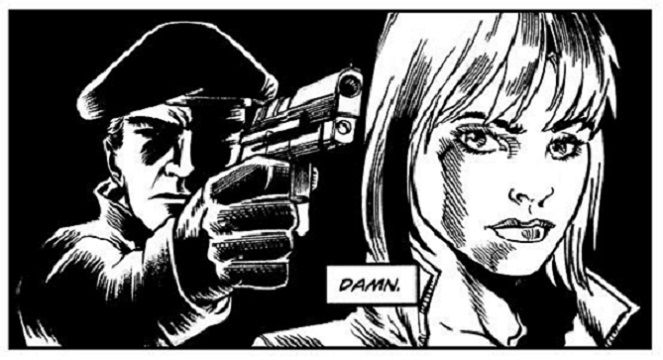
1st: How do digital comics compare to printed ones, do you have a favorite?
Bill: I read lots of comics and I don’t draw the lines quite like that. Digital is just a means of delivery. For example, I read the first half of the excellent Vision mini-series by Tom King on comiXology, and the second half when I bought the trade paperback.
There are projects that are webcomics, comics created for a purely digital environment, or under a ‘digital first’ publishing plan. The Adventures of Business Cat is an awesome webcomic. It makes me laugh every time.
The difference between digital and analog, for lack of a better word, is just the difference in engagement. Earlier this year, I got around to reading The Prince by Machiavelli. While I have a paperback printing of the book, I read it on the Kindle App on my iPhone. In that format, the book is more portable.
We live in a Science Fiction age with outbreaks of futurism all around us, why not take advantage and walk around with a whole library in your pocket?
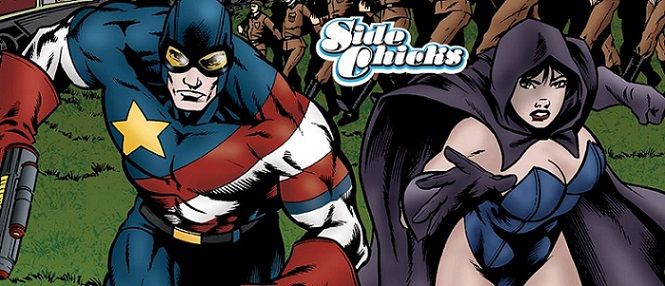
1st: What was special about your work on “Sidechicks”?
Bill: SideChicks is a set of stories about super-powered female bodyguards. One is a super-strong woman with the codename of Tom Boy. The other lead character is a creepy woman in a skull mask named Abessa. Over the course of the series, they become friends as they do bodyguard work. I created about 200 pages for that and the digital comics are available on comiXology.
At some point, I’ll put the finishing touches on the final graphic work and have a trade sized bundle of content. But I get easily distracted by new jobs, so the boring work on the graphic side goes to the back burner.
1st: With 20 years of self-publishing comics what advice do you have for other self-publishers?
Bill: The landscape has changed so much since I started. Back in the day, we shipped art around in Fed Ex boxes. The first comic I printed was done at Brenner Printing in San Antonio. I put together the art pages and sent it to them and they made a film from the pages and kept the negatives on file for me for the longest time. Getting a cover done meant having a colorist turn in the work on a giant disc which was forwarded on to the printer. You didn’t see the errors until the proof came in. All distribution was done through Diamond.
Now, I can assemble an entire comic on my iMac. I work with artists in Brazil and Ohio and we use dropbox to ship the pages around. We can do corrections on the fly and submit the final comic to a digital distributor in an afternoon. In other words, the technical problems have largely been solved.
That means more time can be devoted to the fundamentals of story-telling. There are still gatekeepers at big distribution houses like Diamond or comiXology. But if you start with the smaller houses, there are no wardens and no rules. Just make comics and get them out into the wild. Success breeds more success.
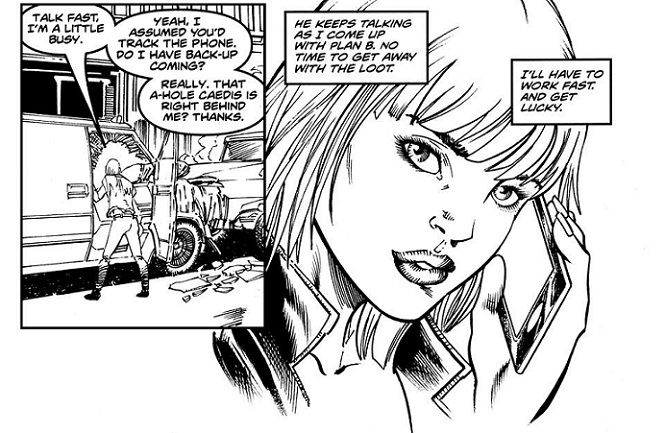
1st: What do you have planned next for your career?
Bill: I’m writing and inking the Charmer comic. That’s at the top of the pile. I’m finishing pages for issue #2 and about to do a final polish on the script for #3. We’re doing four issue arcs, so #5 through #8 are mapped out but not scripted and then #9-#12 are thumbnailed. If the series is successful early on, we’ll just keep going and going.
On top of that, I have a coming of age costumed hero project in the works. I’m writing that and the first four full scripts for the 13-page chapters are finished and in the hands of the artist.
1st: Do you believe in magic?
Bill: Tough question. As a human being, I want to believe. Arthur C. Clarke’s Third Law is… ‘Any sufficiently advanced technology is indistinguishable from magic.’ The first portable phone I saw was a handset attached to a backpack. Compared to that, our modern cell phones are almost magic devices. If magic did exist, we’d have pictures of the effects by now.
I think there is comfort in believing that a set of magic rules govern the functionality of the universe. The alternative is believing in chaos. I think I believe in chaos because, in random chance, there is the opportunity for something new. Astronomers are constantly discovering what they think are earth-type planets. On these exoplanets, the conditions for some type of life may exist. I find that a more likely scenario than something Earthbound and magic-based.
In the Charmer comic, what Sam does is psychically manipulate the fundamental forces around us for her own ends. She does this by using specific magical words which are indicated by symbols. I like the graphic representation of the magic in the comic.
1st: What would you like to say to your many fans?
Bill: Thanks for making it through my ramblings to this point. The first issue of Charmer is good, but first issues have to do the heavy lifting for the series. When I told the penciler that the second issue is all fistfights and car chases he kind of shrugged. And then he read the script and agreed.
